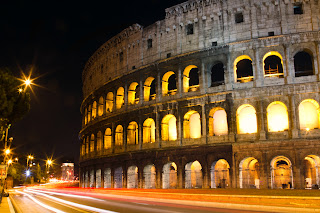The Colosseum - Rome, Italy
The famous Flavian amphitheatre is one of the greatest works of Roman architecture and engineering. Situated in the centre of Rome, it is a "must see" for most tourists. We visited the Colosseum on a walking tour which also included the Roman Forum and the Palatine Hill. The tour itself was not very good but we did get an opportunity to walk around the Colosseum on our own at the end.
Read on for more info.
The Colosseum photographed from the Forum - Rome, Italy
The building was started by Vespasian, inaugurated by Titus in 80 A.D. and completed by Domitian. The Colosseum was used to hold gladiatorial contests, animal hunts, executions and re-enactments of battles. It was later used for housing, workshops and even a christian shrine. The tiers of the Colosseum were able to seat 50,000 spectators around the arena.
Inside the Colosseum - Rome, Italy
Below the wooden floor of the arena was a complex network of rooms, passageways and lifts used to move wild animals from their cages into the arena. The walls which support tiers of seats, passageways and stairways radiate out from the arena. Three tiers of arcades ring the outer edge of the building linking numerous stairways and facilitating the efficient movement of a large number of people. A canopy was suspended form the roof to provide shade.
Exterior of the Colosseum - Rome, Italy
The arches on the ground floor were numbered to allow easy access to seats (some of the number are still visible). Boxes were provided on the North and South sides of the arena for the Emperor and the Vestal Virgins (these were the best seats). Flanking these boxes was reserved seating for the Senators. Some of their names can still be seen carved into the stone. The level above this was occupied by the non senatorial noble class. Ordinary Roman citizens occupied next level up. This level was further divided into two sections for the wealthy and the poor. Gravediggers, actors and former gladiators were banned from the Colosseum.
The Colosseum - Rome, Italy
Outside the amphitheatre stood the Colossus of Nero, a giant bronze statue measuring 30m in height. After the death of Nero the statue was modified to depict the sun god. The statue was last mentioned in the 4th century and only the foundations of the pedestal exist today. It may have been destroyed during the sack of Rome in 410 or in one of the earthquakes that occurred during the 5th century.
The Colosseum - Rome, Italy






No comments:
Post a Comment